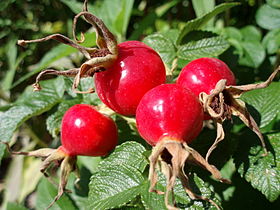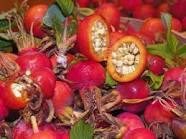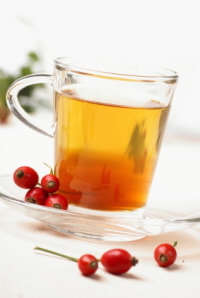Rose Hips are a valuable source of vitamin C, containing as much as 20 times more vitamin C than oranges. They are also an excellent antioxidant.

Rose Hips
If you suffer from the pain and stiffness of chronic osteoarthritis, there’s good news. Studies suggest you may find some comfort from using a natural supplement known as rose hip to treat the symptoms. This fruit, derived from the rose plant, is not only an excellent source of vitamin C but studies show that it may reduce the symptoms of osteoarthritis and help sore, achy joints function better.
Rose hip has long been used as an ingredient for herbal tea and is sometimes enjoyed in syrups, jellies, and even wine. This dark red fruit is certainly no stranger to the world of alternative medicine and could be described as a nutritional superstar with its high iron and vitamin content. It has an antioxidant potential even greater than that of blueberries. It’s also a good source of flavonoids, the phytonutrients that have received so much attention for their beneficial health properties.
Harvesting rose hips is very straightforward. They should always be removed from the stem of the rose plant. (Do not remove the rose once it has died off or you will not have any Rose Hips) Rose hips ripen after they are touched by the first fall frost this is when they are the sweetest. At the time of harvest, hips should be firm with a little give in texture and bright red or orange in color. If any of the hips on the plant are shriveled or are not the right color, do not collect them; they will not go to waste, as they will provide a great treat for the birds, rabbits, squirrels, and deer in the area. The color of rose hips varies, but in general, orange hips are not quite ripe, and deep red hips are overripe. Overripe hips are sweet, but have lost much of their vitamin C.
Rose hips will have the most nutritional value when used immediately after harvesting. To prepare rose hips for tea, cut off the bloom stem, cut the hip in half, and scrape out the seeds and hairy pith. This can be very tedious with tiny hips, so you may want to save the smallest hips for jellies. Rose hips used for jellies don’t need to be seeded or scraped. A half and half mixture of rose hip juice and apple juice makes a tasty jelly.

After some Frost
Preparing rose hips is also simple; however, make sure that they are prepared as quickly as possible after being harvested, as waiting to do so will compromise a lot of their nutritional value. Once they have been collected from the rose plant they can be used whole, but they have seeds inside of them that have a hairy surface and can cause irritation if eaten. If the rose hips are to be incorporated into anything other than a jam, jellies or juice it is recommended that the insides of the hips are removed before further preparations are conducted. Unless you are drying them for teas. (Further on are the instructions for drying the Rose Hips) To remove the seeds, trim the ends of the hips and then cut them in half using scissors (the hips will be too small to accurately trim and slice with a knife). Then remove seeds, rinse the hips in cold water, and drain them thoroughly.

Lots of Seeds
After the rose hips have been drained, they should air dry to remove any additional exterior moisture. Once the rose hips are trimmed and ready for use, they can either be prepared fresh or dried.
Rose hips are great to use in jellies, sauces, soups, seasonings, or tea. If the recipe in use calls for them to be cooked, do not use aluminum pots, pans, or utensils, as it will deplete the vitamin C levels and alter the color of the rose hips.
Vitamin C is an important part of a balanced diet, and rose hips are a wonderful source of Vitamin C. Anyone looking for a natural, delicious, and easy to prepare source of this important vitamin will benefit from harvesting his/her own rose hips and from the beautiful roses that will grow in the process!
ROSE HIP TEA:
Grind approximately 3-4 cups of rose hips. Boil in 2-3 cups of water for 20 minutes. Strain the liquid to remove the pulp. It’s delicious hot or cold.
- When Using Dried: 2 tsp per cup of boiling water, steep for 10 to 15 minutes.
Tip: Don’t throw them out once they’ve been used to make tea, eat them after you’re done drinking the tea or add to soups or serve as a side at the supper table. They still have a lot of nutritional value even after they’ve been used in teas.

Rose Hip Tea
Rose Hip Marmalade:
Use a glass or enamel pan for this recipe.
Clean rose hips and soak in cold water for two hours.
Simmer in water for two hours.
Strain and reserve liquid for jellies or other recipes.
Measure the mash, and add 1 cup of brown sugar for each cup of mash.
Boil down to a thick consistency.
Pour into sterilized jars and seal.
ROSE HIP JUICE:
To prepare rose hip juice for use in many things, just snap the stems and tails off the rose hips and cook in enough water to almost cover them. Cook until well softened. Put through a sieve. Cook again in less water and again put through a sieve. Repeat once more. Then discard remaining seeds and skins and drain the rest overnight through a jelly bag or several layers of cheesecloth.
The juice can be made into syrup or just stored in the refrigerator in a covered jar, to use from time to time in various recipes that would benefit from the addition of vitamin C. The pulp can be used in jam or jelly to augment the quantity where you are a bit short and to add vitamin C.
Use rose hip juice in any syrup, jam or jelly in place of water – at least partly. It doesn’t have much taste, so it can be used in many different things to add that all-important vitamin C.
One use for the pulp is to spread it thinly on cookie sheets and dry it in a low oven, with the oven door slightly open to allow moisture to escape. When completely dry, break the sheet of puree into smaller pieces and pulverize with a rolling pin. The resulting powder is delicious sprinkled on cereal or beverages, or used in place of a little flour in many recipes.
CANDIED ROSE HIPS:
Snap off the stems and tail of the wild rose hips you have collected. Discard any imperfect ones. Insects like rose hips too, so sort them with care. Split the hips open. With a teaspoon turned over, force the seeds out of the hips. Scrape out any extraneous membrane from the inside. Cover with cold water in a saucepan and bring to the boiling point. Reduce the heat and simmer slowly for 10 minutes. Drain well.
Cook to the boiling point 1 cup sugar, 1/2 cup water, and 1 or 2 pieces of crystallized ginger. Add the drained rose hip pieces (not more than a cupful at a time). Cook slowly until the hips just begin to appear translucent. Using a skimmer, remove the hips from the syrup and spread them on a platter to cool. If you have more hips, cook them in the same way until all are cooked, but never add more than a cupful at a time.
When cool, roll the hips in granulated sugar and spread thinly on waxed paper to dry. These make a healthful snack for the kids. They should be stored in an airtight, childproof glass container.
ROSE HIP CANDY:
Gather rose hips, grind into a paste, mix with butter, and add sugar to sweeten. Shape into balls, put a stick into the balls, and roast them over hot coals and enjoy them as a treat on your camping trips.
ROSE HIP SYRUP:
3 pounds rose hips (ripe)
1 cup honey
Wash hips, remove stems and ends. Use a stainless steel or enamel saucepan. Simmer 15 minutes or until tender. Mash with a wooden spoon. Simmer another 8 minutes.
Pour into several layers cheesecloth and allow to drip over night into ceramic bowl. Squeeze out leftovers. Return juice to saucepan, add honey, and blend well. Bring to boil; boil for 1 minute. Pour into jars and seal. Process in hot water bath for 15 minutes at 5,000 feet.
ROSE HIP AND RHUBARB JAM:
Use slightly under-ripe rose hips. Cut in half and remove seeds with tip of knife.
Combine:
1 cup rose hips
1 cup water
4 cups diced rhubarb
1/2 teaspoon salt
Boil rapidly 2 minutes and add:
2 cups sugar
1 tablespoon grated lemon rind
Boil rapidly 2 minutes. Seal in sterilized jars. Process in hot water bath for 15 minutes at 5,000 feet.

Rose Hip Ball
ROSE HIP CATSUP:
4 quarts ripe berries (red and ripe)
1 clove garlic
2 medium sized onions
1 cup water (or more if necessary)
Boil these ingredients until they are soft. Strain them. Add 3/4 cup of brown sugar. Tie in a bag and add:
1/2 TBS whole allspice
1/2 TBS mace
1/2 TBS whole cloves
1/2 TBS celery seed
2 inch stick cinnamon
Boil these ingredients quickly. Add 1 cup vinegar, cayenne, salt, if desired. Boil catsup 10 minutes longer. Bottle it at once. Seal the bottles with wax. The flavor of this catsup is excellent.
HOW TO DRY ROSE HIPS:
Collect quantities to be dried or made into teas, jellies, juice, pickles, etc., for winter use.
The process is very easy and similar to air drying flowers, follow these directions:
- Sort out the imperfect ones and rinse the batch. Carefully pat dry.
- Line a cookie sheet with a screen, or a sheet of cardboard, or parchment or wax paper and spread them across in a single layer.
- Leave in a dark, well ventilated area for a few weeks, they’ll be ready when they are hard, wrinkly and darker in color.
- You can also do this in the oven on the lowest setting or use a dehydrator.
You can dry them whole or you can cut and seed first (directions below). If mainly using for teas, leaving whole is fine.
Storage: Seal in airtight containers or glass jars, store away from direct light.
HOW TO REMOVE HAIRS & SEEDS:
It is desirable that the hairs and seeds be removed before consuming. The fine hairs associated with the seeds are unpleasant in the mouth and have an irritating action. A few different methods are used, try one of the following:
- Cut in half and shake out seeds, this takes the longest time;
- Cover with water and simmer, then rub through a sieve using the puree;
- Simmer whole Rose Hips in more than enough water to cover, then merely strain. Bottle the juice. Add sugar if desired and process 45 mins. This juice contains Vitamin C and may be added to sauces, soups (not cream soup), puddings, beverages and many other foods.
Did You Know: Women and children were encouraged to gather them during World War II when food supplies were low, the Vitamin C they provided were a much needed source of nutrition and was highly valued over the winter months.’
 Loading... Please wait...
Loading... Please wait...